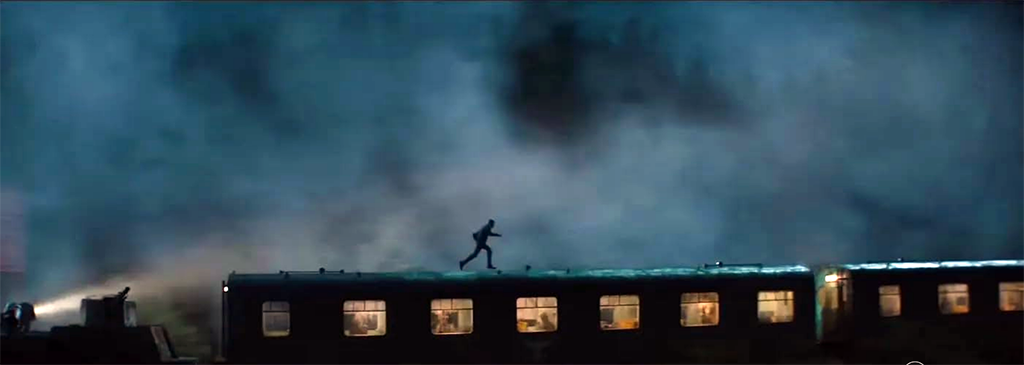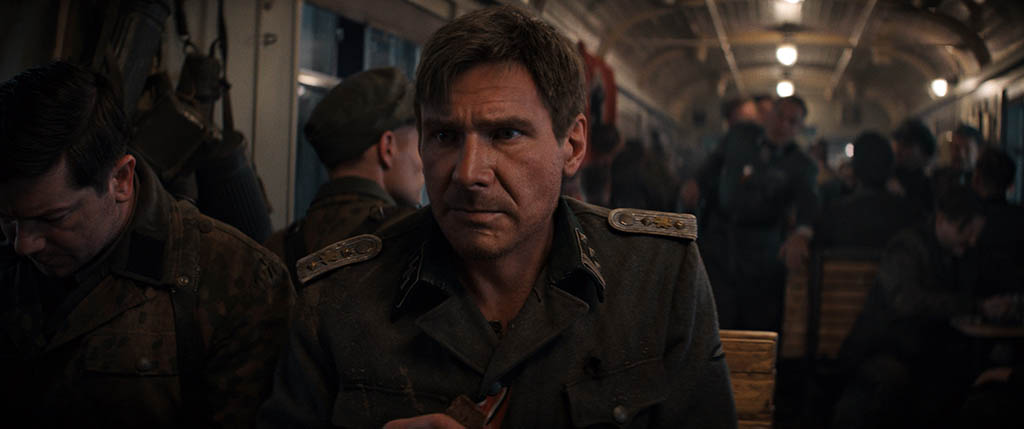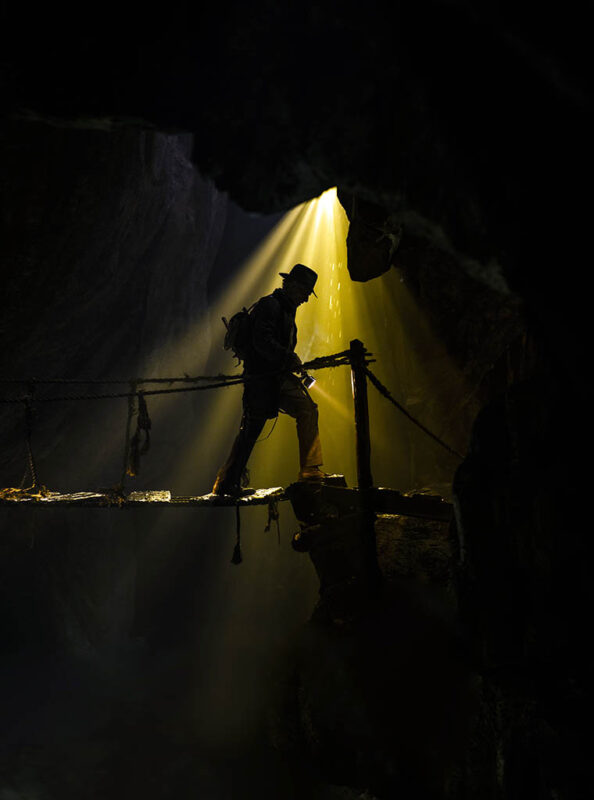By TREVOR HOGG
Images courtesy of Lucasfilm Ltd. and Disney.
By TREVOR HOGG
Images courtesy of Lucasfilm Ltd. and Disney.

The hardest shot to get right for ILM was encountered when the bag is removed and reveals the de-aged Indiana Jones for the first time.
Receiving the franchise baton from Steven Spielberg (Jaws), James Mangold (Ford v Ferrari) embarks on the fifth and final adventure with a character who made archeology, fedoras and bullwhips cool, and provided Harrison Ford with his third iconic cinematic persona. Joining in the fun and global mayhem that ensues in Indiana Jones and the Dial of Destiny is Oscar-winning VFX Supervisor Andrew Whitehurst (Ex Machina) along with ILM VFX Supervisor Robert Weaver.

An array camera car captured plates for the tuk-tuk chase that occurs on the streets of Morocco, which was handled by Soho VFX.
Much has been made of the opening 25 minutes that resembles lost footage from the making of Raiders of the Lost Ark and features a de-aged Harrison Ford. “We started by looking at archival material and building our CG head and A/B between the two, which was a useful comparison,” states Whitehurst, who was on the project for three years. “Early on we had scanned Harrison Ford, so we had him as he is now, which could also be used for checking proportions. There was never ever a particular shot that we thought, ‘This is the one we’ll use to test.’ We all knew that the bag coming off of the head was going to be the most important shot because it’s the first time you see him, and it was also going to end up in the trailer. That was shot early on, and we got working on it earnestly.”

When de-aging Mads Mikkelsen it was more important that he resembled the character of Jürgen Voller rather than his younger self.
De-aging was accomplished by utilizing ILM FaceSwap. “It’s was a terrifying challenge that I wanted to step into and take on,” Weaver remarks. “Things are always evolving, and we’re good at keeping up and leading development in all areas that are necessary to perfect the techniques. Andrew had a good summary of it by stating it’s an umbrella suite of tools. By adding the machine learning to the mix, it’s contributing yet another tool to the arsenal to accomplish what is needed. We did rely on archival footage from past films, and it helped tremendously in many different ways, but it didn’t replace our previous techniques, which we still need to build a fully CG asset that is believable standing on its own as well. It was necessary to treat each shot individually.”


The World War II prologue features a chase on top of a train with Toby Jones, the only character not de-aged. The chase includes an all-CG shot of Ford running across the train.
FaceSwap is not treated as a magic bullet. “What we have is a selection of tools and the ability to mix between the various outputs of these processes that we can look at and go, ‘We’ll take the eyes from here and some of the skin tone from this,’” Whitehurst notes. “To be able to create like a painter would be in that final likeness, and to maintain that performance. The brilliance of it is having the ability to use a little bit of this and more of that. For another shot it is not working, so you have to use a different combination of approaches.”

The parade sequence, which had Edinbourgh stand in for New York City, was the responsibility of Rising Sun Pictures.
Remarkably, Harrison Ford was still able to fit into the original costume. “The long and short of it is, Harrison is super fit and energetic,” Whitehurst states. “He will act like 40-year-old Harrison for those moments.” Ford has a distinct running style described as a cross between Jack Sparrow and Tom Cruise. “We took a lot of time to study his running in various films, and we had an all-CG shot of him running across the train,” Weaver notes. “Essentially, we had to get those mannerisms into that run while working out the cadence of what is necessary to step over the pipes and jump between cars.”

The prologue was intended to resemble recently-discovered lost footage shot during the making of Raiders of the Lost Ark.
“[De-aging Harrison Ford] was a terrifying challenge that I wanted to step into and take on. … By adding the machine learning to the mix [in ILM’s FaceSwap], it’s contributing yet another tool to the arsenal to accomplish what is needed. We did rely on archival footage from past films, and it helped tremendously in many different ways, but it didn’t replace our previous techniques, which we still need to build a fully CG asset that is believable standing on its own as well. It was necessary to treat each shot individually.”
—Robert Weaver, VFX Supervisor, ILM

The de-aging of Ford was accomplished through machine learning and a variety of techniques known as ILM FaceSwap.
When de-aging Mads Mikkelsen, a different creative choice was made. “Mads as younger man is fuller in the face, which didn’t feel right for the character,” Whitehurst reveals. “When we started looking at how we were going to FaceSwap Mads, we decided not to refer extensively to what Mads actually looked like when he was 30. It was more about figuring out what young Jürgen Voller looked like. That was done with a whole bunch of paint tests. We figured out the look for that, and then were able to roll that through the shots. It’s interesting because young Jürgen Voller kind of looks like young Mads Mikkelsen, but also not – that benefits the character.”

ILM created a fully CG environment for the scenes that take place in Syracuse, Sicily circa 214 B.C..
“It was amazing. We could rotate that plane through multiple axis a great deal, and it was full size. But it could also shake around, so we were inside a lot. The physicality was real. That made it tricky because the camera is shaking in the inside, or the plane shaking against the background that shouldn’t be shaking, but the believability of the motion that you get from the people inside of the plane is worth the pain because it sells it.”
—Andrew Whitehurst, VFX Supervisor
Filmmaker Mangold and frequent cinematographer Phedon Papamichael favor using wide lenses for closeup shots resulting in more of the surrounding environment appearing in the frame. “There are probably more closeups of a 40-year-old Indiana Jones in this movie than there are in all of Indiana Jones and the Last Crusade,” Whitehurst observes. “The important thing was being able to accommodate how they wanted to shoot it. I don’t want anyone to ever feel compromised. If it means pushing in and getting close because narratively and dramatically that is going to have the most impact, we should do that.” Among the action sequences is Indiana Jones trying to outrun a subway train while riding horseback. “For the closeups, the train is CG. We had a beautiful set build at Pinewood of the whole station and a little bit into the tunnel. Then we had a long black tent that extended out so he could ride a horse down [the tunnel], so we were able to shoot the plates. but the train was always going to be CG. The actual tunnel itself is CG as well,” Whitehurst says.

Phoebe Waller-Bridge appears in the aircraft gimbal, which was shot on a bluescreen stage. (Photo: Jonathan Olley)
“We do a lot of dynamic studies and various simulations to see what our perceptions are. A lot times in our work, things that are physically correct are not what we’re looking for, so we need to augment them. But in the case of the airplane and all of the atmospherics, James [Director Mangold] had a clear idea in his mind as to what these atmospheric dynamics should be, and he essentially likened them to a waterfall flowing out into the past. That was our cue to build this massive storm and put the dynamics onto the planes that are believable… It was a fine balance to walk.”
—Robert Weaver, VFX Supervisor, ILM


Ford strikes a classic pose while Cinematographer Phedon Papamichael scouts a set. (Photos: Jonathan Olley)
A signature stunt is Indiana Jones leaping from tuk-tuk to tuk-tuk during the street chase in Tangiers. “That was shot in Morocco,” Whitehurst reveals. “We have a guy in a tuk-tuk who will then jump into the other tuk-tuk. We did a CG takeover of the tuk-tuk that he leapt from and have a CG van colliding into it.” Stunts were a crucial partner. “I’ve worked with Ben Cooke, who was Supervising Stunt Coordinator a couple of times. Dan Bradley is an incredibly experienced second unit director. Once we figured out where we wanted to shoot the tuk-tuk. which was Fez in Morocco, Dan went there. The dialogue needed to happen, so we roughly knew how long the sequence had to be, as well as where we were going in and out of it. But the script didn’t describe specific action beats. Dan walked around Fez and said, ‘We could do this with the tuk-tuks right here.’ On the basis of that, we were able to previs the sequence. We scanned and photographed Fez and the vehicles down the whole route because we knew that there was going to be process back at Pinewood for all of the dialogue between our principals. Because everything was previs, we knew what the angles were going to have to be. We decided to put the edit together as we were shooting the process work so we knew that everything was going to cut together okay. Then it’s a case of paring things down in the edit and refining until we get the completed sequence.”

Frequent collaborators filmmaker James Mangold and Cinematographer Phedon Papamichael enter the world of Indiana Jones together for the first time. From left: Production Designer Adam Stockhausen, Mangold and Papamichael on set. (Photo: Jonathan Olley)
ILM was also responsible for the third act. “There are some fantastic escapades that happen with the airplane going through the eye of the storm and coming into 214 B.C.,” Weaver states. “They did an amazing job on set shooting a partial version of the airplane, and we would add an extended version of that through CG at various times. There were other times where things couldn’t be filmed practically, and it would have to be completely CG, partially airborne and jumping out.” The proper weight of the aircraft had to be conveyed to add to the sense of peril. “We do a lot of dynamic studies and various simulations to see what our perceptions are,” Weaver remarks. “A lot times in our work, things that are physically correct are not what we’re looking for, so we need to augment them. But in the case of the airplane and all of the atmospherics, James had a clear idea in his mind as to what these atmospheric dynamics should be, and he essentially likened them to a waterfall flowing out into the past. That was our cue to build this massive storm and put the dynamics onto the planes that are believable, getting enough wind flex that is believable but doesn’t feel like those wings are going rip off in any minute. It was a fine balance to walk.”
“I always push to get as much as we possibly can in-camera, particularly if it’s something that is interacting with the characters because you get better performance. The physicality is there because it’s real. If you can’t do that, we try to find reference that is as close as we can get to that and then analyze it even for the small things.”
—Andrew Whitehurst, VFX Supervisor
A rig was built for the interior of the plane by the special effects team led by Alistair Williams. “It was amazing,” Whitehurst explains. “We could rotate that plane through multiple axis a great deal, and it was full size. But it could also shake around, so we were inside a lot. The physicality was real. That made it tricky because the camera is shaking in the inside, or the plane shaking against the background that shouldn’t be shaking, but the believability of the motion that you get from the people inside of the plane is worth the pain because it sells it. Then that helps when we cut to the exteriors and have felt this violence, and now we can see that in the wider shots.” Practical elements are essential even when shots become fully CG. “I always push to get as much as we possibly can in-camera, particularly if it’s something that is interacting with the characters because you get better performance. The physicality is there because it’s real. If you can’t do that, we try to find reference that is as close as we can get to that and then analyze it even for the small things. For example, the hanger doors open, we see the bomb for the first time and the engines fire up. One of the things with old airplane V engines is when the propellers start to spin, too much fuel is going into the engine, so it’s not up to speed yet, so you get this big blast of flame that comes out through the exhaust. We did that, and it looks cool as well. It adds that extra flavor and verisimilitude to it that there is a bit more texture,” Whitehurst says.

Cinematographer Phedon Papamichael prepares a driving scene on a bluescreen set. (Photo: Jonathan Olley)
Combining reality and fantasy is a staple of the Indiana Jones franchise, such as having a portal appear in the sky for Indiana Jones and the Dial of Destiny. “Indy films are slightly earthy, grubby-real, but then have an element of the supernatural on top,” Whitehurst observes. “We stylistically absolutely had a precedent in the previous films. One of the things that James and I talked about a lot was a Douglas Trumbull cloud tank, where it’s something that feels physical and real but has an interesting aesthetic quality to it as well. Certainly, we were looking at that when designing the inside of the portal as we fly towards 214 B.C. and when we come out of the other side. We designed something that had an interesting physicality to it so it felt like something that nature might produce. We had these arms wrapping around the horizon as if it was coming to Earth trying to grab [it], with this portal in the center of it. There was an oddness to it. But we were also referencing actual cloud formations and odd storm footage a lot to get the movement and the shapes within that form. There was an overall sculptural design aspect to it that we wanted it to narratively feel like, which was threatening, but also getting that naturalism into it that is very Indy.”

Interestingly, Ford still fits into the original costume and has remained extremely fit. (Photo: Jonathan Olley)
A complete CG environment build was the Sicilian city of Syracuse circa 214 B.C.. “It was down to the level of being able to fly through the streets,” Weaver reveals. “Basically, we wanted to take away any limitations that James may have in telling the story. Wherever he wanted to put the camera, it was going to be completely believable and period appropriate.” In total, 2,350 visual effects shots were created by ILM, Rising Sun Pictures, Important Looking Pirates, Soho VFX, Midas VFX, The Yard VFX and Crafty Apes. “The tricky thing with a movie like this is, there were so many locations and numerous times where every single scene is something new,” Whitehurst states. “Somebody asked me, ‘What was it like to make this?’ It was like doing 12 commercials simultaneously, and a lot of them are very different. That’s the hard part. There is a little action beat towards the end when Helena is on a motorbike chasing Voller. I loved it when we did the previs. I thought it was going to be a fun moment. We shot it with Phoebe Waller-Bridge on a soundstage. She was awesome, and we blasted her with water and wind all day long. Phoebe just did it and completely sold it. Also, there is an awesome shot with Phoebe right under the tail of the plane as it’s bouncing down the runway, and you feel it slam down just next to her. I love that whole beat. It feels exciting, present in the action. The performance is great, and the work is beautiful.”